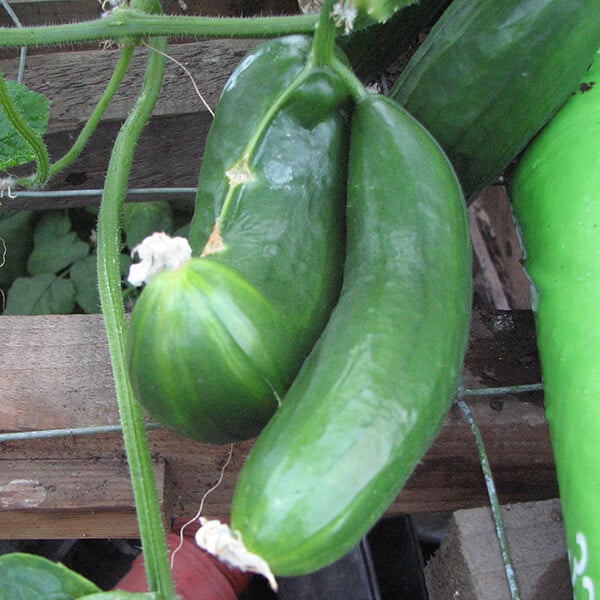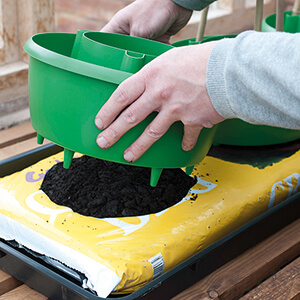Two Wests & Elliott's Gardening Guide To Growing Cucumbers
Cucumbers are a greenhouse favourite and are very straight forward to grow. With different varieties available to growing indoors or out, raising your own crop of cucumbers couldn’t be easier.
Selecting The Right Variety
Cucumbers can be divided into three basic types:
Slicers – these are the standard cucumber, usually growing between 6-9” long, although there is a wide range of varieties which range from the short 4” long to up to 14” in length.
Pickling – these cucumbers tend to be much shorter, around 3-6” long and 1” wide and have a bumpy or spiny skin. These varieties tend to be crunchier than the standard slicers.
Lemon Cucumbers –these varieties are round and grow to about the size of a tennis ball. The round varieties tend to be sweeter and can be eaten fresh or pickled.
Some cucumber varieties have now been bred that are good for both slicing and pickling.
Within these three types, cucumbers can be divided between those types which should be grown in a greenhouse – such as Aidas, Carman, Danimas, Petita etc - and those suitable for growing outdoors – for example Bush Champion, Burplass Tasty Green, Jazzer, Marketmore etc. Alternatively, you’ll also find varieties that can be grown indoors or out.
They can also be divided between vining varieties which have long vines, and bush varieties with shorter vines.
Sowing & Growing
Depending on the variety you have chosen, you can start sowing in early spring in a heated greenhouse or a few weeks later if you’re growing in an unheated greenhouse or outdoors.
Sowing & Growing Indoors
Indoor varieties are best started in a heated propagator. Sow the seeds in 3” diameter pots, planting two seeds on their side ¾” deep within the seed compost, water and place within your propagator set to between 15-21*C depending on the variety – all female varieties need the warmer temperature.
Seeds will germinate in about 7 days. Keep the seedlings moist and once they have grown to about ½” tall, remove the weakest of the pair – to avoid disturbing the roots of the remaining seedling simply snip the weakest one away.
After about 8-10 weeks the seedlings will have become sturdy plants strong enough to be transplanted into grow bags or large pots. If growing in grow bags, make sure the plants have sufficient compost for their roots by increase the amount of compost available to the plants by using plant halos or grow pot towers.
|
Plant Halos In A Grow Bag The 'spikes' around the base of the Halo are the 2.8cm watering spikes which penetrate below the surface, designed to deliver water direct to the plants roots. With six around the base of the Halo they ensure that water and liquid feed are delivered at a reduced rate that the plant is better able to absorb. Click here to see full details. |
The plants will need to be provided with some form of support as they grow. Use garden canes tall enough to reach the top of your greenhouse or polytunnel and regularly secure stems to the cane with suitable plant ties.
Once they reach the roof, pinch out the tip of the plant. Pinch out the shoots on side branches holding the fruit, leaving just two leaves in place after the fruiting flower – if you’re growing an all female variety the side branches can be removed completely as the fruit forms on the main stem of the plant.
Sowing & Growing Outdoors
With outdoor varieties you have the choice to either start the plants off indoors or plant them straight into the ground outdoors.
When starting indoors, sow 2-3 seeds in individual pots, thinning to the strongest plant once they are around ½” tall. Cucumbers do not like their roots to be disturbed; you can avoid this by planting the seeds in bio-degradable pots – such as Jiffy pots.
Once ready to plant out, you can plant both plant and pot together so avoiding possible root damage and enabling the plants to establish quickly.
Plants can be transferred outdoors in early summer, once the threat of frost has passed – cucumber plants are very vulnerable to frost, with even a light frost killing the plants. A week or so before planting into your garden get the plants use to the cooler conditions by placing them in a cold frame.
When starting outdoors, prepare the ground before planting by digging in a far amount of organic matter. This will ensure the plants have sufficient nutrients for healthy growth and will help to improve soil drainage and balance the pH which cucumber plants prefer. Remember, you can only start planting outdoors once the chance of frost has passed, waiting until soil temperatures are about 20*C – to help soil reach this temperature cover the ground where you are going to plant with a cloche about two weeks before you expect to start planting.
|
Easy Tunnel Cloches
The polythene version is ideal for warming the ground prior to transplanting your cucumber plants. Click here to see full details. |
Growing In Rows
Cucumbers grow best in a well protected, sunny spot in your garden. Plant in rows 3’ apart, spacing plants 18” apart. To help them to germinate successfully cover with cloches to raise the soil temperature and protect the plants from pests and animals.
Weed regularly but be careful not to go below an inch with your hoe as you may damage the root system, slowing plant growth. To reduce the problem of weeds and helping retain moisture in the soil apply a mulch about 4” deep – this could be wood chips or bark for example.
Growing In Hills
If you don’t want to do a lot of digging, then you can provide these same conditions by growing your plants in raised beds or on small ‘hills’ of compost. To create one of these ‘hills’ dig a hole approximately 18” wide and 12” deep. Add back the soil, mixing in the same amount of compost so that you create a ‘hill’ about 6” high.
These ‘hills’ should be spaced 18” apart for bush varieties and 36” apart for trailing varieties - this amount of space will enable the plants to spread across the ground rather than growing up a cane. If growing in this manner, after five or six leaves have grown pinch out the tip of the plant and allow the side branches to grow.
When growing on ‘hills’, plant a ring of up to 5 seeds 1” deep in the top of the hill. Once the seedlings reach about 1” tall, remove the two weaker plants by snipping them away, leaving the strongest ones to continue growing on its own.
Fertilisation
Cucumber plants have both male and female flowers and it is the female flowers that give rise to the cucumbers and are distinguished from the male flowers by having a tiny cucumber at their base which develops into a full size cucumber.
|
The same plant will have both male and female flowers. The male flowers develop first and will fall without bearing fruit. The second round of flowers will be a mix of both male and female flowers and it is at this point that pollination will take place. If you want to increase pollination and get more cucumbers, you can use a cotton bud to transfer pollen from the male flowers onto the female flowers. |
 |
It is now possible to purchase varieties which are all female flowers – so check this when buying your seed.
Healthy Cucumber Crops
There are basically just two rules to follow when looking after cucumber plants to ensure a healthy crop:
Don’t let the plants run dry – it’s very important that you keep your cucumber plants well watered but not waterlogged – little and often is the rule. You need to ensure the soil your plants are growing in remains moist at all times – don’t water the plants, rather water the soil or compost surrounding the plants - this will encourage the shallow roots to grow strongly.
Keep the plants well fed – you can start feeding your plants once the fruit appears. You need to feed cucumbers at least once a fortnight, with a fertiliser high in potash such as a tomato food. If you’re growing your plants outdoors keep them topped up with organic matter.
The quickest and easiest way to keep your plants in a moist compost and supply them with sufficient feed would be to use plant halos. These let you provide your plants with water – you water into the outer trough so you’re not disturbing the compost the plants are growing in. The inner trough of the grow pot is where your plant is growing – and this is where you’d supply the feed.
Harvesting
Cucumbers are ready to harvest around 50-60 days after sowing.
|
Once they have grown to the expected size, and whilst the skin is dark green in colour they are ready to pick. Don’t leave them on the plants until they become too big – they will loose their flavour and become bitter. If the skin starts to turn yellow this is an indication that they are over ripe and the flavour will be affected. |
 |
Why Grow Cucumbers?
Cucumbers contain nutrients that are especially beneficial to our skin, hair and nails.
They contain a range of minerals in small amounts including Calcium, Copper, Manganese, Magnesium, Potassium and Phosphorous
Vitamins including A, B6, C and K are found in cucumbers
They are very low in calories, only about 15 calories in 4oz of cucumber
Has a high water content – this makes cucumber really refreshing to eat in the hot summer weather.
However, much of the goodness of cucumbers can be found in the skin. So always slice cucumber with the skin in place. By doing so you’ll be making a big difference to the vitamin contents – vitamin A is virtually all in the skin, vitamin C will almost double if you leave the skin in place and folate will increase four fold.
Eating fresh cucumber is the best way of benefiting from all these nutrients – cooking cucumber results in virtually all the vitamins and minerals being lost, whilst pickling cucumbers also results in reducing the nutrients considerably, especially vitamin C.





